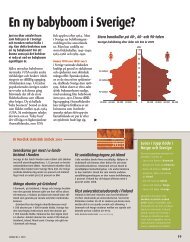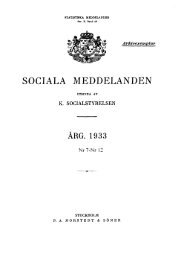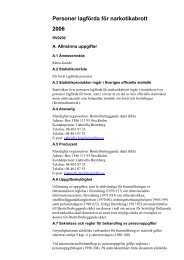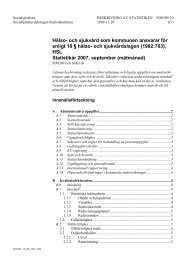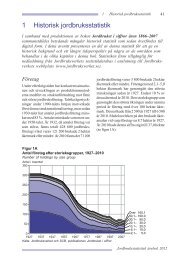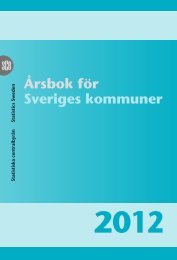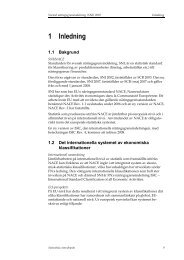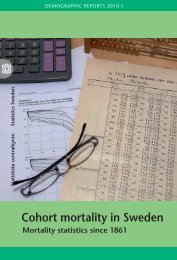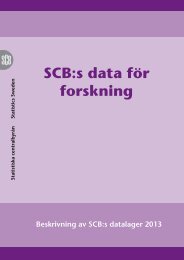Perspektiv på välfärden 2004 (pdf) - Statistiska centralbyrån
Perspektiv på välfärden 2004 (pdf) - Statistiska centralbyrån
Perspektiv på välfärden 2004 (pdf) - Statistiska centralbyrån
Create successful ePaper yourself
Turn your PDF publications into a flip-book with our unique Google optimized e-Paper software.
ered on three occasions, and there are, hence,<br />
eight years between every point of measurement<br />
(for information about the dataset, see below).<br />
The point of departure for the empirical analysis<br />
is taken in figure 1. Three blocks of factors are<br />
distinguished. The first block contains year of<br />
birth, gender and class of origin. These aspects are<br />
exogenous, internally unrelated and also invariant<br />
over time. The rational for including gender and<br />
class of origin is discussed above, but that is not<br />
the case for year of birth. There are, even though<br />
only a very narrow age span is included in the<br />
analysis, probably significant age differences in<br />
the population at the first point of measurement,<br />
and the only reason for including age is to keep<br />
these differences under control. We do not expect<br />
age to have any long-term impact, but we do expect<br />
that age will affect the situation at t 0 . The<br />
second block in Figure 1 contains information<br />
about labour market affiliation, education and<br />
household formation at t 0 , i.e., these factors are<br />
assumed to capture some of the most important<br />
characteristics that, as discussed above, distinguish<br />
between different categories of youth. The<br />
second block is assumed to be dependent on the<br />
first block; labour market affiliation is, for example,<br />
assumed to be influenced by age, gender<br />
an00d, of course, class of origin. We assume that<br />
the characteristics within block two are internally<br />
related. However, no assumptions about causation<br />
are made. Hence, we are, for example, not assuming<br />
that people have left the nest because they are<br />
employed or that they study and therefore are not<br />
employed. The obvious reason is that the direction<br />
of causation in both cases could be the opposite,<br />
i.e., some people will study because they cannot<br />
find a job and some will work because they left<br />
the nest.<br />
The last block consists of indicators of economic<br />
circumstances and changes over time in<br />
these circumstances, i.e., the basic outcome variables.<br />
What will be measured are income level<br />
and the incidence of economic difficulties at t 0 .<br />
We 0assume that income level and economic<br />
difficulties covary, but we do not assume a causal<br />
relationship. It is further assumed that change in<br />
income and change in economic problems over<br />
time are affected by the starting level at t 0 . Finally,<br />
we suppose that change in income relates to<br />
change in economic difficulties; that is, if the<br />
income increases we believe that the incidence of<br />
economic problem will decrease, but we do not<br />
assume a unidirectional causal relationship, as it<br />
could be the case that economic problems lead<br />
people to increase their earnings. The model facilitates<br />
an analysis of the impact of class, gender<br />
and other vital circumstances on the economic<br />
situation during the youth period itself and the<br />
Youth<br />
development over time as the transition into<br />
adulthood is made.<br />
Data, method and operationalizations<br />
Data sources<br />
The analyses are based on data from the annual<br />
Swedish Survey of Living Conditions (ULF) (Häll<br />
and Vogel 1997). ULF is based on a representative<br />
sample of the Swedish population aged 16 to<br />
84. In 1979, a panel approach was introduced and<br />
since then a sub-sample has been re-interviewed<br />
every eighth year. Thus, it is now possible to analyse<br />
a three-wave panel covering a period of 16<br />
years. To maximize the available sample size,<br />
data from 1979, 1980, 1981 and 1982 are merged.<br />
The panel samples from these four years were reinterviewed<br />
a second time in 1986, 1987, 1988,<br />
1989 and 1990 and a third time in 1994, 1995,<br />
1996, 1997 and 1998 2 . The average non-response<br />
rate was 14.4 per cent during 1979-82, increased<br />
to an average of 21.0 per cent for 1986-90 and<br />
21.3 per cent during 1994-98. For the sake of<br />
convenience, the first panel wave will be labelled<br />
t 0 , the second t 1 and third t 2 . The working sample<br />
has been limited to those who were between 19<br />
and 25 years old at the first wave, and accordingly<br />
between 35 and 41 years old when data for the<br />
third wave were collected. The working sample is<br />
made up of 1,435 respondents, representing those<br />
who participated at all three waves.<br />
Operationalizations of variables<br />
The main outcome variables are income and an<br />
indicator of economic difficulties. Income is<br />
measured as the individuals’ income before tax<br />
recalculated to 1998's prices. Hence, what is analysed<br />
is the overall capacity to earn an income<br />
regardless of income source and taxation. The<br />
income measure should not be viewed as a direct<br />
indicator of economic well-being. Taxes will of<br />
course impact the amount of money left for consumption,<br />
and we do not know the household’s,<br />
i.e., the consumption unit’s, income or size. By<br />
focusing on the0 individual income, we do not<br />
risk blurring the analysis by the substantial<br />
changes in disposable income and, even more so,<br />
in equivalent disposable income that are caused<br />
by changes in household composition. The distribution<br />
of the income variable is shown in table 1.<br />
Instead of using income, direct information<br />
based on survey questions will be used as an indication<br />
of economic standard, or to be more cor-<br />
2<br />
The sample from 1979 is about twice as large as the<br />
latter sample, and the panel is split so that half the<br />
sample were re-interviewed in 1986 and the other half<br />
in 1987.<br />
71




